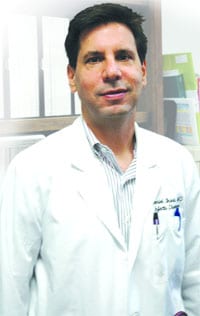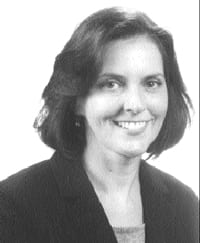Combating The Crunch Enrollment Is Rising In Area Nursing Programs, But Worries Remain
Strategies to combat the national nursing shortage in the long term must begin on the nursing-school level. And, to be sure, colleges are reporting an upswing in enrollment in their nursing programs.
But is it enough?
Current analysis suggests that it isn’t, said Kathleen Ann Long, president of the American Association of Colleges of Nursing (AACN). While enrollment in entry-level baccalaureate programs is up 8{06cf2b9696b159f874511d23dbc893eb1ac83014175ed30550cfff22781411e5} in 2002-03 over the previous year, the upward trend needs to increase even more in order to meet the projected demand for 1 million new and replacement nurses over the next 10 years.
“Schools across the country have done an excellent job in responding to the nursing shortage and getting the word out about career opportunities in nursing,” Long said. “We are encouraged by the upswing in enrollments, but understand that we have a long way to go before we come close to meeting the projected demand for nurses in the foreseeable future.”
Northeastern states have shown the greatest average increase in enrollment this year, at 10.7{06cf2b9696b159f874511d23dbc893eb1ac83014175ed30550cfff22781411e5}, and area colleges report similar growth in their own numbers — perhaps a response to the constant news about the nursing shortage, and the realization among students and those looking to switch careers that nursing is a field of opportunity.
However, the highly competitive job market, with its appeal of immediate, well-paying work, has cut somewhat into master’s-level programs in this region, while doctorate programs — which prepare students for nursing education jobs, which are also facing a shortage — aren’t, as a rule, keeping up with demand.
There’s a lot to be concerned with, nursing advocates say, but as long as the overall enrollment trends remain positive, the industry has something to build on.
Moving On Up
Ann Glanovsky, director of Nursing at American International College in Springfield, told The Healthcare News that baccalaureate enrollment is way up — and that simply makes sense, as licensed practical nurses (LPNs) see the opportunities in their profession for those with higher degrees.
“The interest put forth by LPNs has been noticeable to me,” Glanovsky said. “They see that their opportunities for upward mobility, either where they are or going somewhere else, would be enhanced with a B.S.N. They look at the ads in the paper, which, many times, include ‘B.S.N. preferred.’ They know that’s the preferred degree.”
That’s a trend that appears to be most common in the Northeast. This year, nationwide, enrollments in RN-to-baccalaureate programs declined 2.1{06cf2b9696b159f874511d23dbc893eb1ac83014175ed30550cfff22781411e5}, even as total enrollment rose significantly.
Meanwhile, the trends seem to be reversed for nursing graduate enrollment, which is growing by a 3.5{06cf2b9696b159f874511d23dbc893eb1ac83014175ed30550cfff22781411e5} clip nationwide, while the University of Massa-chusetts, for example, is seeing the opposite — perhaps because the nursing crunch is more severe in this region.
“Our graduate program has seen a slight decline in enrollment,” said Eileen Breslin, dean of the UMass School of Nursing. “It’s primarily because of the nursing shortage and the very competitive salaries being offered; nurses just aren’t returning for graduate work.”
While master’s programs that provide training for roles such as nurse practitioner, clinical nurse specialist, and nurse midwife are becoming less popular in the area, doctoral programs, the ones that prepare students for faculty roles in nursing, are getting plenty of interest. UMass’ collaborative doctoral program with the Worcester Graduate School of Nursing has seen a surge of qualified applicants, so much so that the school can’t accept nearly all of them.
“We have more applications for the Ph.D. program than we can accommodate, so there’s plenty of interest in that,” Breslin said. “We’ve seen a move away from preparing to be nurse administrators. Now there is an increased interest in the nurse educator role.”
Greater Needs
Enrollment trends have always been cyclical, following the job market, Glanovsky said, similar to the way a well-publicized teaching shortage a decade ago led to an eventual glut of candidates on the market.
However, “the shortage we’re looking at in nursing is slightly different,” she said. “Part of the reason for the shortage is that nurses are retiring.” The ‘graying’ of nursing, as many call it, has seen the average age of nurses rise well into the 40s, and between age, opportunities for retirement, and simple burnout from a challenging job, an exodus of nurses from the field is expected in the next decade.
That means the new crop of nurses must do more than keep up with the status quo — and, so far, the numbers still fall short. Yes, the latest surge in interest has raised baccalaureate enrollment from 106,557 in 2001 to 116,099 in 2002 at the 578 schools surveyed by the AACN. But that’s still well below the 127,683 enrolled in 1995 — a time when shortages and looming retirements weren’t the issues they are today.
“Though enrollments are moving in the right direction, we are far from satisfying the demand for nursing care in this country,” said Geraldine Bednash, executive director of the AACN. “The shortage is having a devastating effect right now on our health care system’s ability to provide safe patient care, and much more must be done to dramatically expand student capacity at our nation’s nursing colleges and universities.”
That means thinking more creatively, in many cases. To overcome a shortage of nursing faculty, funding cuts, and other obstacles, schools are forming partnerships with clinical agencies to support mutual needs, lobbying for continued state and federal monies, retooling their marketing strategies, and stepping up efforts to expand diversity and recruit new populations into nursing — including men.
The need is dire, according to many health organizations. According to a recent U.S. Department of Health and Human Services report last year, the number of states with a shortage of registered nurses is expected to grow from 30 states in 2000 to 44 in 2020. Meanwhile, the New England Journal of Medicine recently found that 53{06cf2b9696b159f874511d23dbc893eb1ac83014175ed30550cfff22781411e5} of physicians and 65{06cf2b9696b159f874511d23dbc893eb1ac83014175ed30550cfff22781411e5} of the public cited the shortage of nurses as a leading cause of medical errors. At the same time, the Journal of the American Medical Association reported that more nurses at the bedside could save thousands of patient lives each year.
Support System
Hospitals recognize the need for colleges to attract more nursing students into the profession, but they’re doing their part as well to draw more interest, and that involves creating an environment where nurses will feel they can grow, said Sharon Smith, vice president for Patient Care Services and the chief nursing officer for Baystate Medical Center.
“We have an atmosphere where people feel it’s important to grow in their education,” she said. “We take any opportunity to secure more scholarship funds so people can get the support they need to go to school. Of course, Baystate has tuition reimbursement, but I’m talking about additional funding.”
Institutions know they must counter the high stress of many nursing jobs by creating such an environment. And stress is certainly a factor in the nursing crunch. According to the Mass. Hospital Assoc., while RN vacancies average 9.9{06cf2b9696b159f874511d23dbc893eb1ac83014175ed30550cfff22781411e5} across the state, some high-pressure fields, such as inpatient oncology, telemetry, critical care, and medical/surgical, report nursing vacancy rates of up to 15{06cf2b9696b159f874511d23dbc893eb1ac83014175ed30550cfff22781411e5}. Meanwhile, 68{06cf2b9696b159f874511d23dbc893eb1ac83014175ed30550cfff22781411e5} of hospitals rate their nursing shortages in at least some departments as ‘moderate’ or ‘severe.’
“You hear people talk about salaries, but, all things being equal, there are other things that staff members want,” Smith said. “They want to be valued in their job and be highly regarded as professional colleagues, and part of that comes by expanding their education and professional certification.”
No one doubts that opportunities abound in the world of nursing. But as retirements open up even more opportunities, furthering the education of existing nurses won’t be enough. New blood is at a premium. And, so far, it’s not coming in waves.



